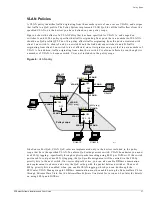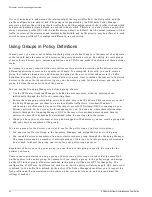
36
EPICenter Software Installation and User Guide
EPICenter and Policy Manager Overview
profiles (QP1 through QP4 or QP8) that allow access, within the bandwidth and priority constraints
defined by the QoS profile. An access rule intended to deny access from one endpoint to another is
implemented in the EPICenter Policy Manager using the “blackhole” QoS profile.
IP-based QoS policies (or Access List policies) are supported on Extreme devices running ExtremeWare
5.0 or later— all i-series devices, and non-i-series devices running ExtremeWare 5.0x. This means that all
devices in the scope for an IP policy must be running ExtremeWare 5.0 or later.
Source Port Policies
A Source Port policy identifies traffic originating from a specific port on an Extreme switch, and assigns
that traffic to a QoS profile. In the policy definition, you specify as endpoints the specific ingress ports
from which the traffic will originate. As shown in Figure 5, a source port policy is always
uni-directional and implements Source Port QoS on the traffic flow from the specified source port.
Figure 5: Source Port policy
You can specify multiple source ports in a single policy, and you can specify them by providing
higher-level resources such as a host name, user name, or a group, as long as the resources can be
mapped by the Policy Manager to a port on a switch. If you specify a group, only the resources within
the group (and its subgroups) that map to source ports will be used as policy endpoints.
In the case of source port QoS, the endpoint specification and the scope are theoretically redundant,
because the endpoint specification effectively defines the scope of the policy. However, you must specify
both the endpoint and the policy scope. If there are devices in the policy scope (for example, when the
scope resource is a group) that are not related to the ports specified as endpoints. These will not be
affected by the source port policy definition. For more details, see “Policy Access Domain and Scope”
on page 41.
Unlike IP QoS, a Source Port QoS rule is implemented only on the device where the source port resides.
However, you can enforce QoS throughout the network using 802.1Q tagging—specifically by explicit
packet marking using 802.1p or DiffServ. If the switch ports used for output use 802.1Q tagging, the
QoS profile assignment will be carried via the 802.1p priority bits to the next switch. On i-series chipset
devices, you can also enable DiffServ examination and replacement to observe and carry the QoS setting
with the packet between switches. The use of 802.1p priority bits is enabled when you enable tagging,
which you can do using the EPICenter VLAN Manager applet. DiffServ examination must be enabled
using the ExtremeWare CLI or through ExtremeWare Vista. See the ExtremeWare Software User Guide for
versions 6.0 or later for details on using 802.1p and DiffServ.
Source port QoS policies are supported on Extreme devices running ExtremeWare 5.0 or later— all
i-series devices, and non-i-series devices running ExtremeWare 5.0. This means that the endpoints used
to define Source Port policies must be on devices running ExtremeWare 5.0 or later.
XM_018
Server
Policy scope
IP address
QP2
QP2
(802.1p tag)
Summary of Contents for EPICenter 4.1
Page 20: ...20 EPICenter Software Installation and User Guide Preface ...
Page 46: ...46 EPICenter Software Installation and User Guide EPICenter and Policy Manager Overview ...
Page 190: ...190 EPICenter Software Installation and User Guide Configuration Manager ...
Page 204: ...204 EPICenter Software Installation and User Guide Using the Interactive Telnet Application ...
Page 242: ...242 EPICenter Software Installation and User Guide Using the IP MAC Address Finder ...
Page 266: ...266 EPICenter Software Installation and User Guide Using ExtremeView ...
Page 284: ...284 EPICenter Software Installation and User Guide Real Time Statistics ...
Page 436: ...436 EPICenter Software Installation and User Guide Using the Policy Manager ...
Page 454: ...454 EPICenter Software Installation and User Guide The ACL Viewer ...
Page 468: ...468 EPICenter Software Installation and User Guide Troubleshooting ...
Page 504: ...504 EPICenter Software Installation and User Guide EPICenter External Access Protocol ...
Page 510: ...510 EPICenter Software Installation and User Guide EPICenter Database Views ...
Page 522: ...522 EPICenter Software Installation and User Guide EPICenter Backup ...
Page 526: ...526 EPICenter Software Installation and User Guide Dynamic Link Context System DLCS ...
Page 546: ......






























